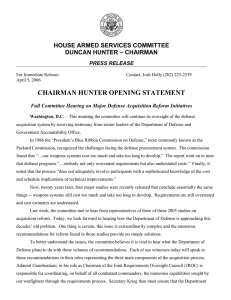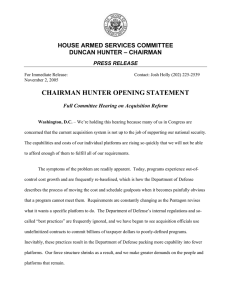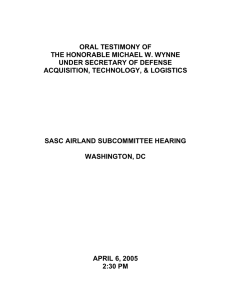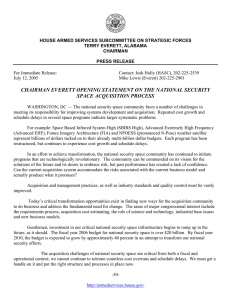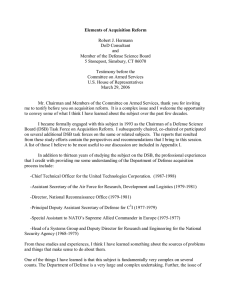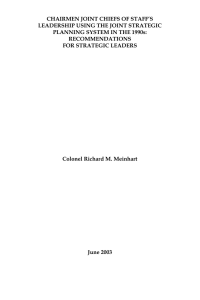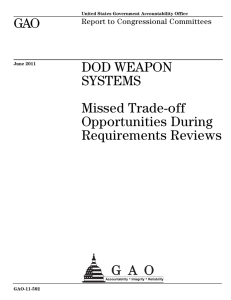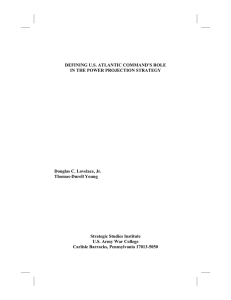STATEMENT OF ADMIRAL E. P. GIAMBASTIANI, USN VICE CHAIRMAN OF THE
advertisement
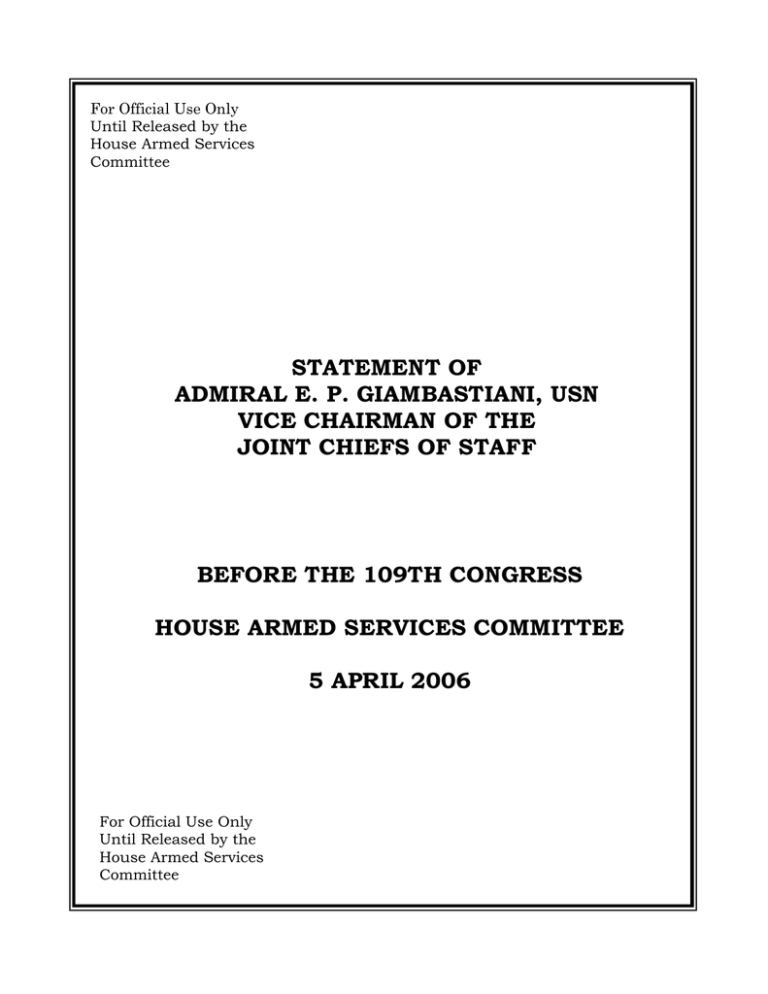
For Official Use Only Until Released by the House Armed Services Committee STATEMENT OF ADMIRAL E. P. GIAMBASTIANI, USN VICE CHAIRMAN OF THE JOINT CHIEFS OF STAFF BEFORE THE 109TH CONGRESS HOUSE ARMED SERVICES COMMITTEE 5 APRIL 2006 For Official Use Only Until Released by the House Armed Services Committee 1 Chairman Hunter, Representative Skelton, distinguished members of the Committee; it is my pleasure to testify today on the contributions of the Joint Requirements Oversight Council, and the requirements process it oversees, in reforming our acquisition practices in the Department of Defense. First though, on behalf of all Soldiers, Sailors, Airmen, Marines, and our families, thank you for your continued bipartisan support. That support has been exemplified this past year by Congressional visits to our troops in Iraq, Afghanistan, and elsewhere around the world; visits to those hospitalized; your funding for operations; your support of transformation and recapitalization initiatives; and the improved pay and benefits you have provided to our Service members and their families. Improving the ability of our requirements and acquisition processes to deliver capabilities to the Joint Warfighter is a key element of the Department’s ongoing transformation agenda. This transformation imperative informed the Quadrennial Defense Review’s direction on business process reforms. These business process reform efforts will be driven by QDR Execution Roadmaps and overseen collaboratively by the leadership of the Department of Defense. In my testimony today, I want to focus on the role the requirements process should play in acquiring truly “joint” capabilities and the efforts my colleagues and I on the Joint Requirements Oversight Council and the Defense Acquisition Board have undertaken to achieve this goal. As a prelude to this discussion, numerous reviews of the acquisition process in the past have pointed to key aspects of the requirements generation process that have driven up costs and delayed delivery. Among these “cost drivers” are the establishment of unrealistic or unachievable requirements and the evolution or “creep” of requirements 2 over time. The first problem – unrealistic requirements - reflects an aspiration that science and technology will advance in time to deliver a desired future capability. It is often an aspect of programs with inherently long lead times and extensive research and development programs, such as some shipbuilding or aviation stealth programs. The second problem – requirements “creep” - occurs when technology advances faster than our acquisition process expects, often in those areas in which the commercially driven research and development outpaces that of the Department of Defense, in areas such as communications or information technology. In both cases, they result from a laudable desire to deliver the best possible, state of the art capability to the Joint Warfighter. But they also result in inefficient and expensive programs which often deliver late and sometimes deliver not at all. In our efforts to improve the requirements process, my colleagues and I on the Joint Requirements Oversight Council and the Defense Acquisition Board are working to craft a process which achieves the following objectives: • Links requirements to approved Joint Concepts of Operations • Incorporates the capability needs of the Combatant Commanders • Limits the technology risk at a level appropriate for the capability being developed. • Identifies which requirements are most likely to drive costs and schedule and provides options for senior leaders to “descope” requirements when cost growth threatens capability delivery. • Provides appropriate review by senior leadership early in the requirements process and throughout the acquisition process so 3 that rational and informed “risk balancing” decisions can be made by the senior civilian and military leaders of the Department. Needless to say, this is a tall order, but not unachievable. I am pleased to report that in each of the 20 JROC meetings and 12 DAB meetings I have attended since becoming Vice Chairman of the Joint Chiefs of Staff on 8 August 2005, some or all of these topics have been addressed. We are working and learning together and taking an incremental and pragmatic approach to reforming our requirements process even as we proceed with defining the capabilities the Joint Warfighter will need for the future. I am encouraged by the progress we have made to date. Let me share some of the highlights: • We now have a body of Joint Concepts of Operations to inform our requirements development. Based on a Capstone Concept for Joint Operations and four Joint Operating Concepts [Major Combat Operations, Stability Operations, Homeland Defense and Strategic Deterrence], we are creating a common capability lexicon. Most recently, Secretary Rumsfeld approved 21 top tier Joint Capability Areas which map out the types of capabilities required by the Combatant Commanders in executing their missions. This will help all of us involved in capability development – Services, Defense Agencies, Combatant Commanders and the Joint Staff – think more clearly, and more jointly, about what we need to deliver for the future. And, when we consider “jointness” conceptually, we need to think more broadly to include Allied, coalition and interagency, as well as multi-service, operations and requirements. • The JROC is evaluating capabilities documents with more concern for technology risk and cost drivers. From my personal perspective, 4 I always ask for the history behind the requirement; whether the Key Performance Parameters (KPPs) have changed over time; which requirements drive the cost of the program and what “requirements trade space” we can take advantage of. I have found that in some cases, the most important, the most costly and the most frequently changed requirements are not found among the JROC approved KPPs. My intention, as Chairman of the JROC, is to ensure the JROC has firm control over the KPPs and Key System Attributes (KSAs) which drive cost and risk and that the JROC is involved up front in any changes to them. • The JROC and the DAB have begun to work together to review programs in the execution phase which are running over cost and behind schedule. As a team, we revalidate the requirements and review the acquisition strategy to put these programs back on track. As two salient examples of this teamwork, I would single out the Joint Tactical Radio System (JTRS) and the Future Imagery Architecture (FIA), the latter program also working closely with Under Secretary Cambone’s team. Ideally, this work should start sooner rather than later – before the parameters of the NunnMcCurdy Act are breached. We are working together to identify performance metrics we can use to intervene earlier and more effectively in programs experiencing difficulty. These are just some of the initiatives that Under Secretary Krieg and my colleagues on the JROC have undertaken together. The teamwork and collaboration have been exemplary. That’s good, because there is a lot more work to be done. We need to make our system more agile, more responsive, less bureaucratic and fully informed by a coherent body of Joint Concepts, Joint Experimentation and Joint Lessons Learned. 5 This is a challenge I am committed to meeting. It is one of the reasons I came to Washington to serve as the Vice Chairman of the Joint Chiefs of Staff – having lived with a non-optimal system as a warfare requirements director, a Service Programmer and a Combatant Commander. I look forward to continuing our work with the Acquisition Community and the Resource Community to tackle these challenges and I look forward to the support and advice we find here on this Committee. I look forward to taking your questions. 6
